Five years after landmark agreement in Sabah, government shows signs of moving forward on wildlife corridors
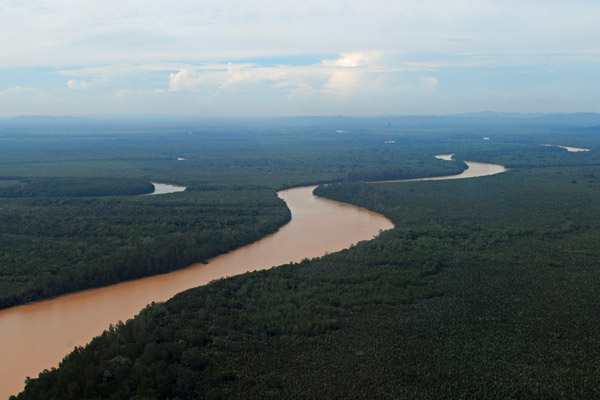
The Kinabatangan River winds through rainforest and palm oil plantations in the Malaysian state of Sabah on Borneo. Photo by: Axri Sawang/HUTAN.
Five years ago an unlikely meeting was held in the Malaysian state of Sabah to discuss how to save orangutans, elephants, and rhinos amid worsening forest fragmentation. Although the meeting brought together longtime adversaries—conservationists and the palm oil industry—it appeared at the time to build new relationships and even point toward a way forward for Sabah’s embattled forests.
Participants of the meeting drew up a detailed plan that included creating wildlife buffer zones of 100 meters along all major rivers, connecting forest fragments, and barring any more land development in the lower Kinabatangan River. To much fanfare, the state government even pledged land acquisitions to make this happen. Five years later and conservationists say little has changed on the ground in the Kinabatangan landscape and the outlook for its wildlife may be even worse, however recent events hint that the government may now be ready to act.
“Few of the promises made during the colloquium have been met for Kinabatangan,” Marc Ancrenaz, the head of the NGO HUTAN, told mongabay.com. HUTAN was one of the main organizers of the 2009 colloquium along with the Malaysian Palm Oil Council (MPOC), which declined the opportunity to comment for this article.
Yet, according to Ancrenaz, the state government has made significant conservation progress in other parts of Sabah, including expanding protected forests. Today, 20 percent of Sabah’s land mass is under some form of protection (well above the global average). Moreover, 75 percent of the state’s remaining orangutans are now in protected areas.
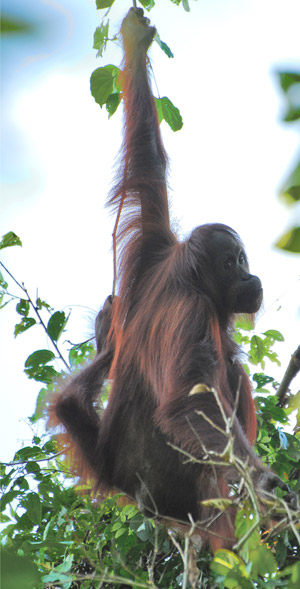 Orangutan hanging in Kinabatangan. Photo by: Daisah Bin Kapar/HUTAN. |
“We need to congratulate the government for this result,” Ancrenaz said.
But with all the progress, the Kinabatangan River landscape has been left behind, even though it’s a hugely-popular tourist destination for travelers keen on seeing pygmy elephants, proboscis monkeys, orangutans, and many other species.
“Nothing has really changed for the Kinabatangan floodplain and biodiversity there is still eroding fast,” noted Ancrenaz. “The business-as-usual approach regarding land-use development and economic choices still prevails.”
New glimmers of hope for the Kinabatangan River landscape came last month, however. For the first time government officials alongside local community representatives removed around eight hectares of palm oil trees that had been planted illegally alongside the river, replacing them with native trees. The government says this a part of a new strategy to regain wilderness and a high-profile meeting is set later for this week. But whether this is a one-off publicity stunt or the beginning of making good on five-year-old promises remains to be seen.
Ecosystem imperiled
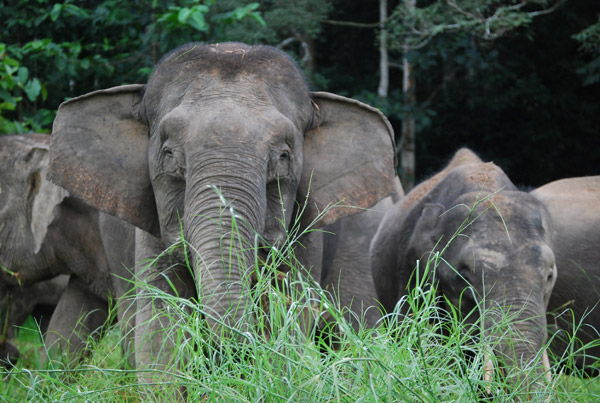
Bornean elephants, the smallest in the world, in riverine habitat. Photo by: Marc Ancrenaz/HUTAN.
The Kinabatangan River floodplain is at the heart of the struggle between more palm oil plantations and wildlife in Sabah. Driving towards Kinabatangan, palm oil plantations spread as far as the eye can see, a great wave of green. But this green isn’t natural: it’s a heavily industrialized monoculture imported from Africa.
A comprehensive study in 2008 found that palm oil plantations lost 83 percent of species when converted from lowland rainforest. Another study in 2009 argued that palm oil may be “the single most immediate threat to the greatest number of species” by driving deforestation of rainforests and carbon-rich peatlands.
According to Ancrenaz, the Kinabatangan floodplain is the last major river in Sabah that retains significant forest cover, including linking coastal mangroves with inland forests. But, key wildlife populations are eroding fast in the ecosystem. Ancrenaz said that proboscis monkeys are vanishing, threatening tourism; large hornbills are declining due to dwindling suitable trees to nest in; and conflict between humans and elephants are on the rise as the pachyderms lose habitat and raid fields for food.
“In Kinabatangan more and more elephants are poisoned and shot by people: a minimum of six elephants were killed during the last six months close to Sukau and two orphans were rescued during the same time,” Ancrenaz said. Last year, the killing of 14 elephants in the state made headlines, but no one was ever convicted of the crime.
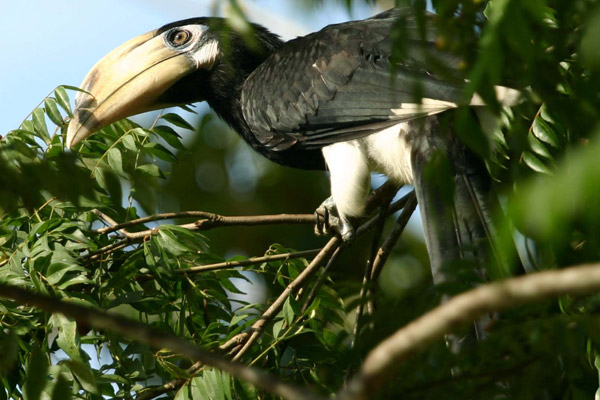
A hornbill in the Kinabatangan landscape. Photo by: Jamil Sinyor/HUTAN.
And what about the most iconic animal in Borneo? Ancrenaz noted that the population of Bornean orangutans in Kinabatangan dropped from 1,100 individuals in the early 2000s to about 800 today—nearly a 30 percent fall in just over a decade. Across Sabah, the state has lost 90 percent of its historical population of orangutans.
But the news is even worse for Sabah’s rhinos. John Payne, the executive director of the Borneo Rhino Alliance (BORA), has said before that he believes there are likely less than ten Sumatran rhinos left on the island, most of them in Sabah. However, the species are not so threatened by ongoing deforestation, but by sheer rarity.
And some species in the Kinabatangan floodplain may already be extinct.
“The state of fisheries is extremely preoccupying, with possible extinction of endemic species (study on going), strong decline of many species (commercial or not), [and an] increase of invasive species,” said Ancrenaz. “The freshwater ecosystems in Kinabatangan and in Segama are slowly dying.”
Meanwhile palm oil plantation expansion continues in the Kinabatangan landscape despite pledges five years ago by the government banning new developments. Government officials ignored repeated requests for comment for this story.
“Alienated land forests found in extreme lowland areas are still primarily converted to oil palm plantations: today there is even less natural forest in Kinabatangan than five years ago,” Ancrenaz told mongabay.com. “Today, forest fragmentation is even worse than before in Kinabatangan. Fragmentation is the number one threat to the survival of most wildlife populations in Kinabatangan and Segama [floodplains].”
Are corridors the key?
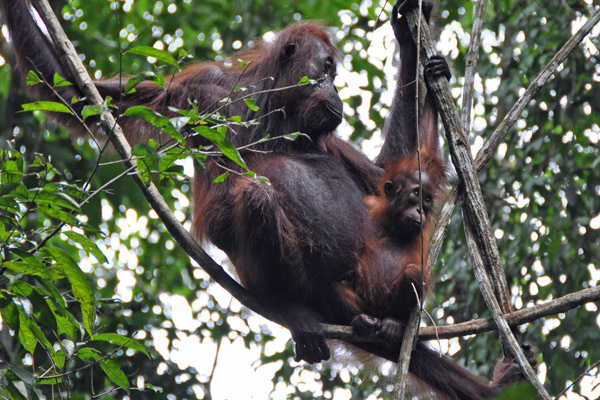
Orangutan family in the Kinabatangan landscape. Photo by: Dzulirwan bin Takasi/HUTAN.
One of the most important parts of the agreement at the colloquium in 2009 was the pledge to create wide swathes of wildlife corridors. Theoretically these would take two forms. Oil palm plantations would abandon plantings 100 meters along river banks, creating unbroken habitat for wildlife to use along the riverside as well as creating an ecological buffer against pollution and run-off. Meanwhile, attendees pledged that remaining forest fragments would be connected via wildlife corridors. But why the focus on wildlife corridors?
“Animals need to disperse to find food and to find mates. When the forests are divided in small patches by other types of land-uses, some species cannot cross the landscape anymore (gibbons for example). The result of this fragmentation is that these species are dying off slowly,” explained Ancrenaz, adding that orangutans will also need corridors if they are to survive in Kinabatangan.
“Orangutans cannot swim: every time a plantation digs a drain for example, they cut off populations in smaller subpopulations. Small groups of orangutans that are isolated are not viable in the long-term.”
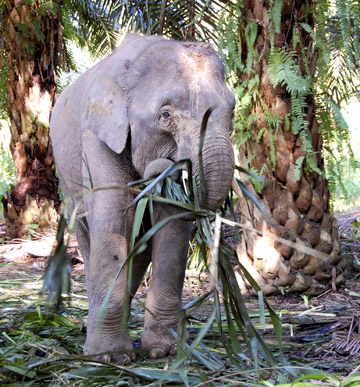 Bornean elephant feeding in a palm oil plantation. Photo by: Marc Ancrenaz/HUTAN. |
However, not all conservationists are convinced that wildlife corridors are the key to Sabah’s wildlife woes.
“‘Corridors’ are one of the biggest messes in nature conservation in recent decades. The idea has been seized by all manner of observers who have little biological experience or knowledge,” John Payne, the head of BORA, told monagaby.com. “There is no need for contiguous forests along every river. All forms of life will either totally fail to adapt to a predominantly plantation landscape, in which case their future will be in Forest Reserves and protected areas. Or, the others will adapt, and the issues are how far they are likely to walk or fly through plantations.”
Instead of focusing on corridors, Payne said conservationists should consider forest “stepping stones.”
“Stepping stones of forest patches within plantations will ultimately prove to be nearly as good as contiguous habitat corridors, and much easier to achieve.”
According to Benoit Goossens, the director of Danau Girang Field Centre in Sabah, it may all depend on what species conservationists intend to protect.
“Corridors can be tiny stretches of forest for some species, or can even be palm oil plantations for others. However, our research carried out on several species (clouded leopard, sun bear, elephant, proboscis monkey, monitor lizard, civet, etc.) using satellite technology shows that forest corridors are primordial for wildlife movements,” he told mongabay.com.
Ancrenaz noted it was especially important to have unbroken corridors along the riverbanks to help fisheries, but that stepping-stones could be an option in other landscapes.
Whether it be corridors, stepping stones, or some combination of the two, if wildlife is to persist in Sabah’s once-forested river landscapes they will certainly need more help and better-managed landscapes.
Obstacles aplenty
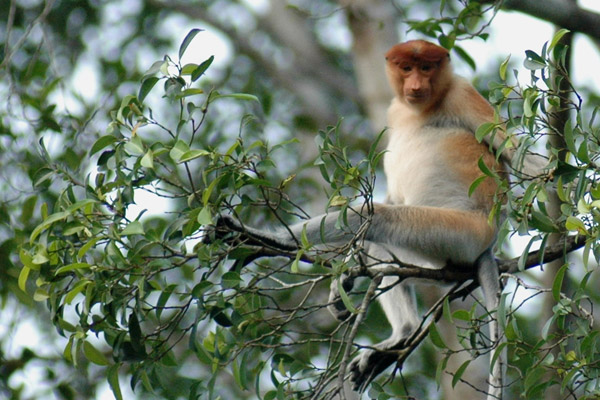
Proboscis monkeys are vanishing from the Kinabatangan and other parts of Borneo. Photo by: Marc Ancrenaz/HUTAN.
Yet the battle to create forest corridors in Sabah has proven an uphill one, and for years it appeared that the government was unwilling to broach the challenge.
“Oil palm companies that had illegally planted palms up to the river bank were supposed to give back this land to conservation in order to recreate a contiguous forest corridor,” said Ancrenaz. “Sadly, most of the companies haven’t made any progress at all and you can still see oil palms up to the river bank in many sites along the Kinabatangan River.”
To date, a few forest corridors have been secured in Kinabantagan by NGOs, such as HUTAN, Mescot-Kopel, the Borneo Conservation Trust, RiLeaf, LEAP, and financial assistance from the World Land Trust, as well as by private companies such as Nestle and Sime Darby. Still, progress remains slow and has in no way met the goals articulated at the conference.
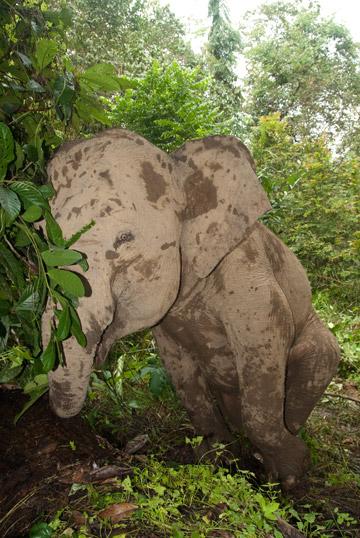 Bornean elephant in the Kinabatangan landscape. Photo by: Marc Ancrenaz/HUTAN. |
The core of the problem is that in today’s marketplace, oil palm is far more lucrative than rainforest. Even if the rainforest provides numerous ecosystem services, they aren’t accounted for by economists. For example, Sabah’s government garners about 20 percent of its income from taxes on palm oil, meaning the government has a huge stake in, not to mention close ties to, how palm oil companies perform.
“Recent analysis show that out of 1.4 million hectares of oil palm plantations that has been developed in the state over the past 30 years, 70 percent has replaced forest,” said Ancrenaz. “Acknowledging the real problems would be a first step forward for a sustainable future.”
Not all palm oil companies are guilty of ignoring pledges for corridors along rivers, though. For example, PBB Oil, a subsidiary of Wilmar, has left a 60-meter corridor along the lower Segama River. Moreover, lucrative palm oil companies have increasingly pledged funding to conservation research and groups. For example, large palm oil company, Sime Darby, is one of the biggest funders for Sabah’s Borneo Rhino Sanctuary and its Borneo Sun Bear Conservation Center. Meanwhile the Malaysian Palm Oil Council supports a wildlife rescue center and wildlife patrol units.
But Ancrenaz says while they are beneficial, they don’t address the fundamental issues underlying biodiversity loss across the state. For one thing, a simple lack of communications around land-use decisions leaves many conservationists in the dark until its too late.
“A lot of decisions are taken unilaterally without proper discussion between stakeholders and without considering the ecological needs of major wildlife populations. For example, oil palm plantations are still developed in forests that are prime orangutans habitat or used extensively by elephants for their migration,” Ancrenaz noted. “Engaging with scientists and wildlife managers before the land-use allocation is done would prevent a lot of further conflicts.”
John Payne also points to a large rise in land prices making it difficult for the government to acquire land for corridors. He noted that in some places land prices have jumped 40 times in 20 years, and even more where palm oil is planted.
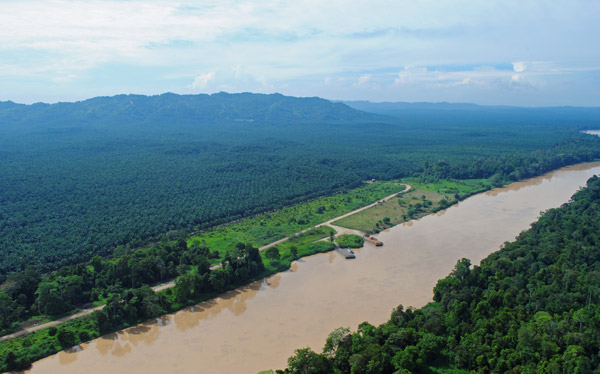
Kinabatangan River: oil palm plantation on the left, rainforest on the right. Photo by: Azri Sawang/HUTAN.
“The situation is that all land is worth acquiring as a matter of principle, but not worth acquiring if the same money could be put to alternative use. Spending say RM 50 million [$15.4 million] to acquire say 1,000 hectares is difficult to justify,” he said, adding that politics plays a role too. “When a piece of land is small, and owned by an individual local person, the land might be their livelihood, and it would make little sense for government to acquire such small-holdings, unless hundreds of such small-holdings were to be acquired, in which case the government would lose its voters in that community.”
Payne recommends instead starting but going after the big companies and asking for what he calls, “voluntary allocation of portions of land within plantations.”
“That is not happening mainly because no-one has an idea of which bits of land that are best set aside, and so no-one is going to the CEOs and main shareholders to put up their proposals. There is a big gap here in the potential role of interested NGOs.”
Ancrenaz agreed that convincing big companies to voluntarily leave corridors could be key to breaking the impasse between conservationists, the government, and the palm oil industry. In this case, he sees the need for more collaboration between the palm oil industry and conservationists, collaboration similar to what led to the conference in the first place.
Going forward
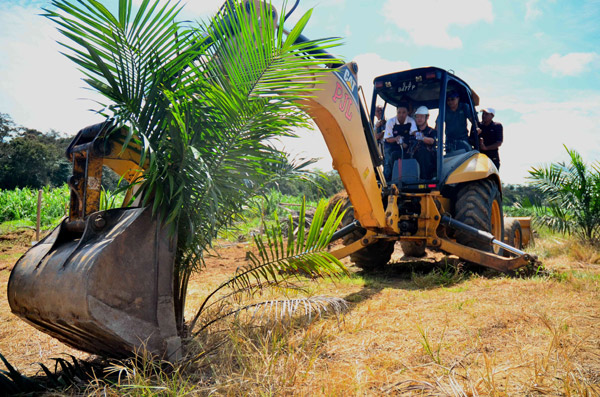
Datuk Pang Yuk Ming in command of the excavator, pulling out an oil palm tree. Photo by: Baharudin Budin/Danau Girang Field Centre.
In fact, things may be changing in Sabah. Last month, the state’s Assistant Minister of the Ministry of Tourism, Culture and Environment (MTCE), Datuk Pang Yuk Ming, personally tore an illegally-planted palm oil tree out of the ground. An excavator was used to clear around four hectares of palm oil encroachment in a reserve on the banks of the Kinabantagan River and native trees were planted in their place.
However, this first foray was small: just four hectares of palm oil were removed and planted with native trees. Still, it could be the beginning of something much bigger and closer to the government’s pledges in 2009.
“This initiative…is the precursor of many more of this kind,” said Datuk Pang Yuk Ming in a press release. “The government will set up a Special Task Force to focus on recapturing back all the riparian reserves throughout Sabah. Moreover, the State Government should make law violators pay for the cost of putting back natural trees in the riparian reserves that they encroached.”
In fact, a major effort to restore lost river reserves could be imminent.
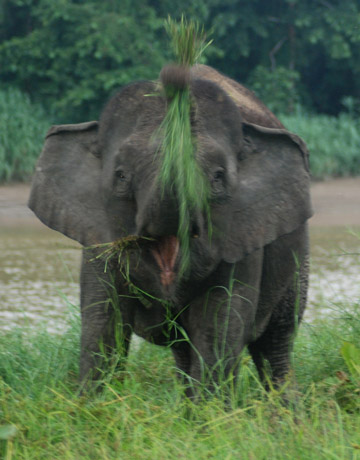 Bornean elephant trumpeting. Photo by: Marc Ancrenaz/HUTAN. |
“The government is currently identifying all areas along the river that need to be replanted with natural trees,” confirmed Ancrenaz, who said the government was holding a multi-stakeholder meeting this week to discuss the new initiative. .
While this is a hugely positive signal from the government, Ancrenaz said what’s really needed in the state is a new way to look at land-use decisions over the long term.
“Sabah is often compared to Costa Rica, in terms of its environmental approach, but we still lack a sound Spatial Master Plan that would identify exactly what land-use allocation would achieve our environmental goals and economic goals at the same time,” he noted.
For Ancrenaz the creation of a state-wide spatial plan that both conservationists and palm oil developers would abide by could not only preserve wildlife but mitigate conflict.
“Land-use decisions are made by considering short term profits only. Long-term opportunity costs are not put into the equation. In the long-term the kind of development that we see in the state is not sustainable….We need a more balanced approach to development that will incorporate social and ecological dimension to development,” he said.
Ancrenaz pointed to a new initiative dubbed Borneo Futures as one possible model. This is a network of groups working on changing how land-use decisions are made not just in Sabah, but across the island of Borneo.
Five years after the landmark orangutan colloquium—a rare moment when conservationists, the government, and palm oil companies appeared not only to acknowledge that there was a problem, but that there were solutions—Sabah may be on the crux of either making good on its promises or allowing wildlife to continue to vanish from the Kinabantagan River landscape.
“I believe it is always easier to make recommendations at a meeting, but that the implementation of these recommendations can take many years,” said Benoit Goossens, adding, “especially because we are only a handful number of people working hard on the implementation.”

Clearing for oil palm plantation along the river in 2012. Photo by: Rhett A. Butler.
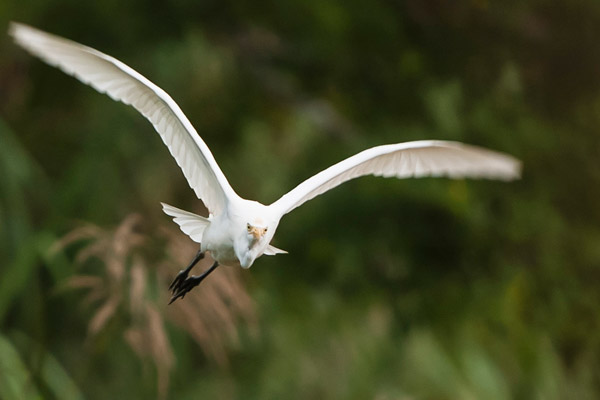
The Kinabatangan landscape is home to a wide variety of bird species. Photo by: Marc Ancrenaz/HUTAN.
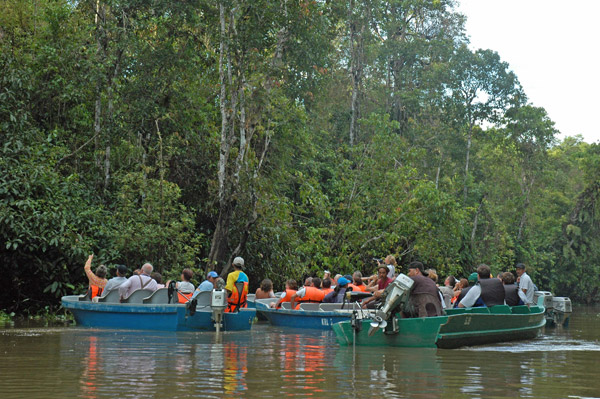
Tourists scan forests for wildlife. Photo by: Jaml Sinyor/HUTAN.
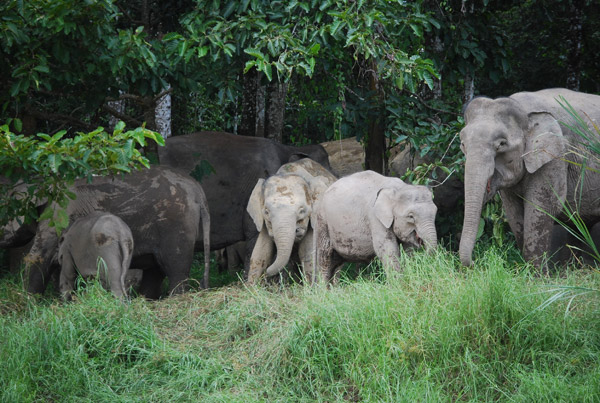
Bornean elephant herd. Photo by: Marc Ancrenaz/HUTAN.
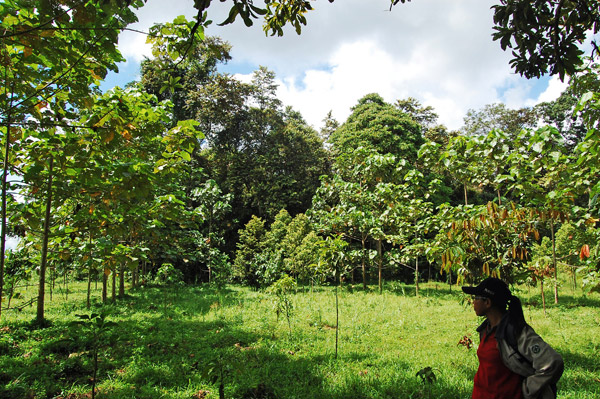
Replanting forest along the Kinabatangan. Photo by: Shernytta Poloi/HUTAN.
Related articles
The palm oil diet: study finds displaced orangutans have little else to eat

(06/20/2014) In a recent study, researchers assessed how orangutans have adapted to living among oil palm plantations on Borneo. They found that while orangutans have adapted to the island’s human-transformed landscapes better than expected, oil palm plantations are unable to sustain orangutan populations in the long-term.
Bornean elephant meets palm oil: saving the world’s smallest pachyderm in a fractured landscape
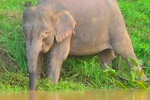
(10/01/2013) In the Malaysian state of Sabah, where most conservation students are still foreigners—either European or American—Nurzahafarina Othman stands out: not only is she Malaysian, a Muslim, and a mother of a young daughter, but she’s rapidly becoming a top researcher and champion for the world’s smallest elephant: the Bornean elephant (Elephas maximus borneensis). Although sometimes described as a pygmy elephant, they still weigh 2,000 kilograms (4,400 pounds). The origin of these ‘tiny’ elephants in Malaysian Borneo have baffled scientists for decades.
Conserving the long-neglected freshwater fish of Borneo
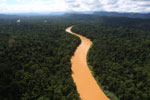
(06/11/2013) Borneo is a vast tropical island known for orangutans, rhinos, elephants, sun bears, proboscis monkeys, hornbills, and ubiquitous leeches. Conservationists have championed all of these species (aside from the leeches) in one way or another, but like many tropical regions Borneo’s freshwater species have long been neglected, despite their rich biodiversity and importance to local people. But a new organization, the Kinabatangan River Spirit Initiative, is working to change that.
Riddled with tumors: another blow to the Sumatran rhino species
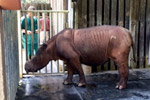
(04/14/2014) Conservation for Sumatran rhinos suffered another blow last week, only days after Suci—one of only ten rhinos in captive breeding efforts—died at Cincinnati Zoo. Scientists in the Malaysian state of Sabah revealed that a newly captured female, Iman, suffers from an assortment of tumors in her uterus, hugely complicating reproduction efforts.
Meet Iman: the Sumatran rhino’s newest hope for survival

(03/24/2014) Hopes for one of the world’s most imperiled megafauna rose this month when wildlife conservationists succeeded in catching a female Sumatran rhino named Iman in the Malaysian state of Sabah. The female, which experts believe to be fertile, has since been successfully transferred via helicopter to the Borneo Rhino Sanctuary where experts plan to mate her with the local male, Tam. Located in Tabin Wildlife Reserve, the Borneo Rhino Sanctuary is an uncompleted semi-wild enclosure and home to one of several last-ditch efforts to save the vanishing species from extinction.
Unraveling the secrets of one of the world’s most mysterious big cats

(12/22/2013) The Sunda clouded leopard has always been shrouded in mystery. Only declared a separate species from its mainland cousin, the Borneo clouded leopard, in 2006, the IUCN lists the cat as Endangered. The distinction between the Borneo clouded leopard (Neofelis nebulas) and the Sunda clouded leopard (Neofelis diardi) was made by ground-breaking molecular coding technologies and anatomy studies of the two species. Although it is Borneo’s largest predator, very little is known about the Sunda leopard. As a medium-sized, well-camouflaged and mostly nocturnal animal, the leopard has evaded researchers since its discovery eight years ago.
New project works to raise the profile of the world’s littlest bear

(12/02/2013) The world’s least-known bear also happens to be the smallest: sun bears (Helarctos malayanus), so called for the yellowish horseshoe mark on its chest, are found across Southeast Asia. But despite their telltale markings, super-long tongues, and endearing cuteness, sun bears remain little-studied and little-known compared to many of the region’s other large mammals. Now, a new project is working to raise the profile of the sun bears of Borneo—Survival of the Sun Bears—which are a smaller subspecies of the mainland animals.
Sumatran rhino population plunges, down to 100 animals

(04/08/2013) Less than 100 Sumatran rhinos survive in the world today, according to a bleak new population estimate by experts. The last survey in 2008 estimated that around 250 Sumatran rhinos survived, but that estimate now appears optimistic and has been slashed by 60 percent. However conservationists are responding with a major new agreement between the Indonesian and Malaysian governments at a recent summit by the International Union for Conservation of Nature’s Species Survival Commission (IUCN SSC).
New palm oil concession imperils orangutan population in Borneo
(01/28/2013) Three conservation groups warn that a proposed palm oil plantation puts a significant Bornean orangutan (Pongo pygmaeus) population at risk in the Malaysian state of Sabah. The plantation, which would cover 400 hectares of private forest land, lies adjacent to Kulamba Wildlife Reserve, home to 480 orangutans.
Photos: camera traps capture wildlife bonanza in Borneo forest corridor
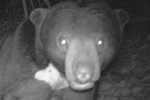
(09/10/2012) Camera traps placed in a corridor connecting two forest fragments have revealed (in stunning visuals) the importance of such linkages for Borneo’s imperiled mammals and birds. Over 18 months, researchers with the Sabah Wildlife Department (SWD) and the Danau Girang Field Centre (DGFC) have photographed wildlife utilizing the corridor located in the Lower Kinabatangan Wildlife Sanctuary in Malaysian Borneo.
What a Bornean elephant wants: more protected forests and wildlife corridors
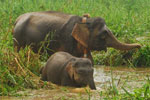
(02/16/2012) Forest fragmentation and destruction is imperiling the Bornean elephant (Elephas maximus borneensis), according to a new paper published in PLoS ONE. Using satellite collars to track the pachyderms for the first time in the Malaysian state of Sabah, scientists have found that the elephants are extremely sensitive to habitat fragmentation from palm oil plantations and logging.
Wildlife official: palm oil plantations behind decline in proboscis monkeys

(12/05/2011) The practice of palm oil plantations planting along rivers is leading to a decline in proboscis monkeys (Nasalis larvatus) in the Malaysian state of Sabah on Borneo, says the director of the Sabah Wildlife Department, Laurentius Ambu. Proboscis monkeys, known for their bulbous noses and remarkable agility, depend on riverine forests and mangroves for survival, but habitat destruction has pushed the species to be classified as Endangered by the IUCN Red List.